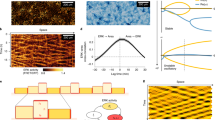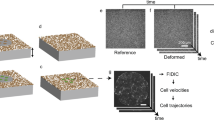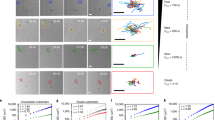Abstract
As a wound heals, or a body plan forms, or a tumour invades, observed cellular motions within the advancing cell swarm are thought to stem from yet to be observed physical stresses that act in some direct and causal mechanical fashion. Here we show that such a relationship between motion and stress is far from direct. Using monolayer stress microscopy, we probed migration velocities, cellular tractions and intercellular stresses in an epithelial cell sheet advancing towards an island on which cells cannot adhere. We found that cells located near the island exert tractions that pull systematically towards this island regardless of whether the cells approach the island, migrate tangentially along its edge, or paradoxically, recede from it. This unanticipated cell-patterning motif, which we call kenotaxis, represents the robust and systematic mechanical drive of the cellular collective to fill unfilled space.
This is a preview of subscription content, access via your institution
Access options
Subscribe to this journal
Receive 12 print issues and online access
$259.00 per year
only $21.58 per issue
Buy this article
- Purchase on Springer Link
- Instant access to full article PDF
Prices may be subject to local taxes which are calculated during checkout




Similar content being viewed by others
References
Rand, H. Wound closure in actinian tentacles with reference to the problem of organization. Rouxs Arch. Entwicklungsmech. Organismen 41, 159–214 (1915).
Keller, R. Developmental biology. Physical biology returns to morphogenesis. Science 338, 201–203 (2012).
Drasdo, D., Kree, R. & McCaskill, J. S. Monte Carlo approach to tissue–cell populations. Phys. Rev. E 52, 6635–6657 (1995).
Farooqui, R. & Fenteany, G. Multiple rows of cells behind an epithelial wound edge extend cryptic lamellipodia to collectively drive cell-sheet movement. J. Cell Sci. 118, 51–63 (2005).
Hutson, M. S. et al. Forces for morphogenesis investigated with laser microsurgery and quantitative modeling. Science 300, 145–149 (2003).
Kiehart, D. P., Galbraith, C. G., Edwards, K. A., Rickoll, W. L. & Montague, R. A. Multiple forces contribute to cell sheet morphogenesis for dorsal closure in Drosophila. J. Cell Biol. 149, 471–490 (2000).
Saez, A. et al. Traction forces exerted by epithelial cell sheets. J. Phys. Condens. Matter 22, 194119 (2010).
Reffay, M. et al. Orientation and polarity in collectively migrating cell structures: Statics and dynamics. Biophys. J. 100, 2566–2575 (2011).
Tambe, D. T. et al. Collective cell guidance by cooperative intercellular forces. Nature Mater. 10, 469–475 (2011).
Trepat, X. et al. Physical forces during collective cell migration. Nature Phys. 5, 426–430 (2009).
Tambe, D. T. et al. Monolayer stress microscopy: Limitations, artifacts, and accuracy of recovered intercellular stresses. PLoS One 8, e55172 (2013).
Angelini, T. E. et al. Glass-like dynamics of collective cell migration. Proc. Natl Acad. Sci. USA 108, 4714–4719 (2011).
Garrahan, J. P. Dynamic heterogeneity comes to life. Proc. Natl Acad. Sci. USA 108, 4701–4702 (2011).
Serra-Picamal, X. et al. Mechanical waves during tissue expansion. Nature Phys. 8, 628–634 (2012).
Trepat, X. & Fredberg, J. J. Plithotaxis and emergent dynamics in collective cellular migration. Trends Cell Biol. 21, 638–646 (2011).
Weber, G. F., Bjerke, M. A. & DeSimone, D. W. A mechanoresponsive cadherin–keratin complex directs polarized protrusive behavior and collective cell migration. Dev. Cell 22, 104–115 (2012).
Sadati, M., Qazvini, N. T., Krishnan, R., Park, C. Y. & Fredberg, J. J. Collective migration and cell jamming. Differentiation (in the press).
Bindschadler, M. & McGrath, J. L. Sheet migration by wounded monolayers as an emergent property of single-cell dynamics. J. Cell Sci. 120, 876–884 (2007).
Basan, M., Elgeti, J., Hannezo, E., Rappel, W. & Levine, H. Alignment of cellular motility forces with tissue flow as a mechanism for efficient wound healing. Proc. Natl Acad. Sci. USA 110, 2452–2459 (2013).
Matsubayashi, Y., Ebisuya, M., Honjoh, S. & Nishida, E. ERK activation propagates in epithelial cell sheets and regulates their migration during wound healing. Curr. Biol. 14, 731–735 (2004).
Block, E. R. et al. Free edges in epithelial cell sheets stimulate epidermal growth factor receptor signaling. Mol. Biol. Cell 21, 2172–2181 (2010).
An, S. S. et al. Hypoxia alters biophysical properties of endothelial cells via p38 MAPK- and Rho kinase-dependent pathways. Am. J. Physiol. Cell Physiol. 289, C521–C530 (2005).
Lu, J. et al. Breast cancer metastasis: Challenges and opportunities. Cancer Res. 69, 4951–4953 (2009).
Mark, S. et al. Physical model of the dynamic instability in an expanding cell culture. Biophys. J. 98, 361–370 (2010).
Wartlick, O. et al. Dynamics of Dpp signaling and proliferation control. Science 331, 1154–1159 (2011).
Lauschke, V. M., Tsiairis, C. D., Francois, P. & Aulehla, A. Scaling of embryonic patterning based on phase-gradient encoding. Nature 493, 101–105 (2012).
Morelli, L. G., Uriu, K., Ares, S. & Oates, A. C. Computational approaches to developmental patterning. Science 336, 187–191 (2012).
Derby, B. Printing and prototyping of tissues and scaffolds. Science 338, 921–926 (2012).
Soule, H. D. et al. Isolation and characterization of a spontaneously immortalized human breast epithelial cell line, MCF-10. Cancer Res. 50, 6075–6086 (1990).
Poujade, M. et al. Collective migration of an epithelial monolayer in response to a model wound. Proc. Natl Acad. Sci. USA 104, 15988–15993 (2007).
Butler, J. P., Tolic-Norrelykke, I. M., Fabry, B. & Fredberg, J. J. Traction fields, moments, and strain energy that cells exert on their surroundings. Am. J. Physiol. Cell Physiol. 282, C595–C605 (2002).
Acknowledgements
We thank L. Kobzik and D. Tschumperlin (Harvard University) and J. H. T. Bates (University of Vermont) for their critical comments. We thank D. Yu (MDACC) for creating stable MCF10A cell lines and M. H. Zaman for providing us with them. This research was supported by the Spanish Ministry for Science and Innovation (BFU2012-38146 and FPU fellowship XS), the Swiss National Science Foundation (PBEZP2-140,047), the National Research Foundation of Korea (2012R1A6A3A03040450), the European Research Council (Grant Agreement 242,993), Parker B. Francis (Fellowship RK), American Heart Association (13SDG14320004) and the National Institutes of Health (R01HL102373, R01HL107561).
Author information
Authors and Affiliations
Contributions
J.H.K. designed cellular migration experiments. X.S-P. and B.G performed staining experiments. J.H.K, X.S-P., D.T.T., M.S., E.H.Z, C.Y.P. and B.G carried out migration experiments and data analysis. D.T.T. contributed software. C.Y.P, J-A.P. and R.K. contributed to protocol designs. E.M. contributed to data analysis. J.P.B. and J.J.F. guided data interpretation and analysis. J.H.K., J.P.B., X.T. and J.J.F. wrote the manuscript. J.J.F. oversaw the project.
Corresponding author
Ethics declarations
Competing interests
The authors declare no competing financial interests.
Supplementary information
Supplementary Information
Supplementary Information (PDF 1738 kb)
Supplementary Information
Supplementary Movie S1 (MOV 6377 kb)
Supplementary Information
Supplementary Movie S2 (MOV 15447 kb)
Rights and permissions
About this article
Cite this article
Kim, J., Serra-Picamal, X., Tambe, D. et al. Propulsion and navigation within the advancing monolayer sheet. Nature Mater 12, 856–863 (2013). https://doi.org/10.1038/nmat3689
Received:
Accepted:
Published:
Issue Date:
DOI: https://doi.org/10.1038/nmat3689
This article is cited by
-
Effect of substrate stiffness on friction in collective cell migration
Scientific Reports (2022)
-
Measuring mechanical stress in living tissues
Nature Reviews Physics (2020)
-
Multiscale modelling of motility wave propagation in cell migration
Scientific Reports (2020)
-
Dense active matter model of motion patterns in confluent cell monolayers
Nature Communications (2020)
-
Spatiotemporal force and motion in collective cell migration
Scientific Data (2020)



